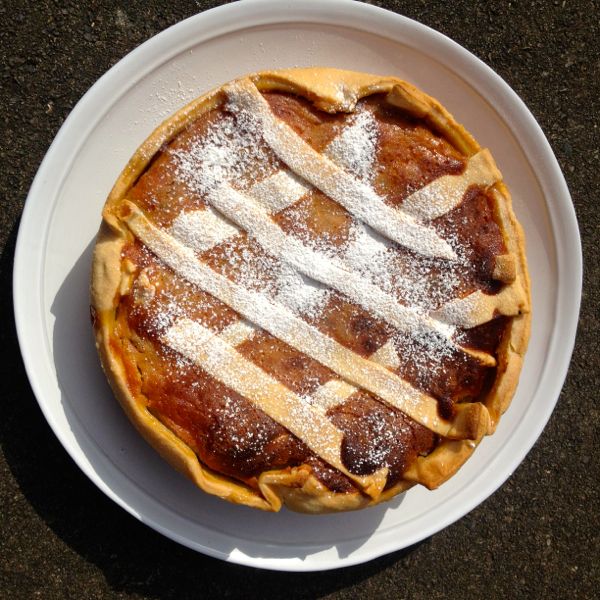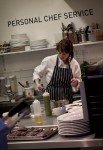Pastiera or Easter Ricotta Tart
 I really admire those organised food bloggers who manage to post seasonal recipes before the event. I’m not quite sure what their secret is, but when it comes to Christmas or Easter or Halloween, I need to find out because I’m posting a recipe for the classic Easter dish of pastiera a week late instead.
I really admire those organised food bloggers who manage to post seasonal recipes before the event. I’m not quite sure what their secret is, but when it comes to Christmas or Easter or Halloween, I need to find out because I’m posting a recipe for the classic Easter dish of pastiera a week late instead.
The good news though is that it’s only a traditional Easter dish if you hail from Naples so technically there’s no reason why you shouldn’t make it in the next few weeks if you like the sound of it. Pastiera is made from pastry filled with cooked wheatberries, eggs and ricotta flavoured with cinnamon, candied peel and orange blossom water and it tastes deliciously of springtime sunshine and light evenings. It’s also much easier to make than I originally expected.
I had difficulty getting wheatberries or grano cotto so I used pearl barley instead. Several recipes suggested using cooked rice as well and I think it would be a wonderful way to use up leftover rice pudding. You do need to make the pastiera a day in advance to allow the flavours to combine but as I am not a proper Neapolitan nonna I didn’t take the traditional three days to create mine. Make it on a Saturday night before tucking in for Sunday lunch for something a bit different. I won’t tell if you don’t.
Pastiera (adapted from this Food 52 recipe here)
- 250g plain flour
- pinch of salt
- 150g cold butter
- 2 egg yolks
- 30ml ice cold water
- 100g pearl barley (uncooked weight)
- 250ml milk
- 50ml cream
- 100g candied peel
- 1 lemon, zested
- 350ml ricotta
- 2 eggs
- 2 egg yolks
- 200g sugar
- 1 tablespoon orange blossom water
- 1 teaspoon vanilla extract
- 2 teaspoons ground cinnamon
- generous pinch of sea salt
- icing sugar to serve
Begin by making the ricotta filling for the pastiera. Wisdom has it that freshly cracked eggs make it rise so you need to rest them overnight. I wasn’t that organised, but I did find that chilling the mixture for at least an hour made it easier to handle so don’t skip that stage.
Beat the ricotta, whole eggs, egg yolks, sugar, cinnamon, vanilla and orange blossom water together well with a fork. It will be alarmingly liquid at this stage and you’ll panic that you’ve done something wrong. You haven’t. Chill it in the fridge and it thickens nicely.
Next make your pastry. I always always use Dan Lepard’s recipe for it and despite not being especially pastry confident, it works best for me. Sift the flour into a large bowl and add the salt. Cut the butter into small pieces and rub into the flour until it disappears well. Beat the egg yolks into the water and add to the flour, mixing it in well. Combine to make a surprisingly soft and wet dough and then wrap it and chill in the fridge for at least 30 minutes.
Prepare the barley for the filling by covering it with cold water and bringing to the boil. Skim any froth off the top and cook for about 20 minutes. Reserve the cooking water to make your own version of barley water, but drain the barley well before returning it to the pan.
This time add the milk and the candied peel and simmer it gently until the barley thickens into a porridgey texture and the fruit swells slightly. This took about 5 minutes for me. Take it off the heat and add the cream and lemon zest and allow to cool for about 20 minutes.
Flour your work surface well and then roll out your pastry to fit a 9 or 10 inch springform cake tin. Don’t cut the overhang yet and allow the pastry to chill for 20 minutes more in the fridge.
Combine the barley with the ricotta mix and stir it all together well. It will, frankly, look unappetising in colour in texture. Ignore the nagging voice that tells you this was a bad idea. It wasn’t. Carry on making it and preheat the oven to 200℃.
Pour the barley ricotta mix into the chilled pastry shell and trim the overhang on the pastry neatly. Lay strips of pastry across the top of the pastiera to make a lattice effect, sticking them on with the leftover egg whites if needs be. Mine sank a bit as I think I cut them too wide and therefore too heavy. But it was nearly midnight at this stage and I didn’t care.
Bake the pastiera for 60 minutes or until the top is golden brown and the pastry is biscuity beige. You need to turn it half way through to make sure the colouration is even on both sides if you are bothered by such things. Take it out and cool completely in the tin.
Chill until needed and then remove from the tin. Sprinkle with icing sugar and serve in slices. The filling is surprisingly light in texture but is is quite rich so do what we did and start with small slices and work up to seconds. The pastiera will keep for up to 3 days in the fridge. I loved the flavour of the cinnamon and orange blossom water together as both were subtle but effective. It made a lovely change from chocolate or marzipan Easter treats!


























